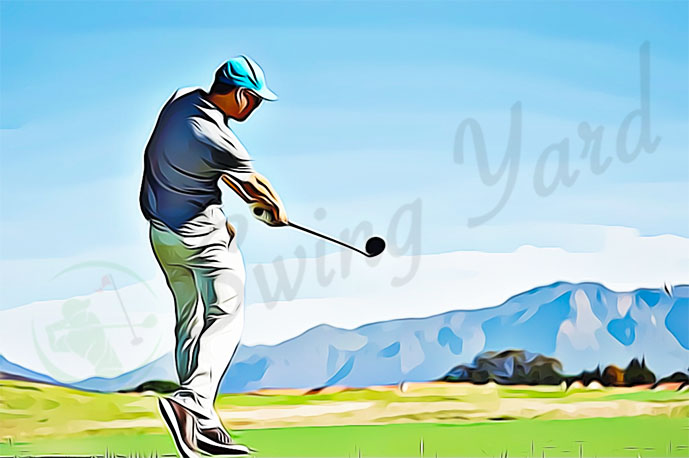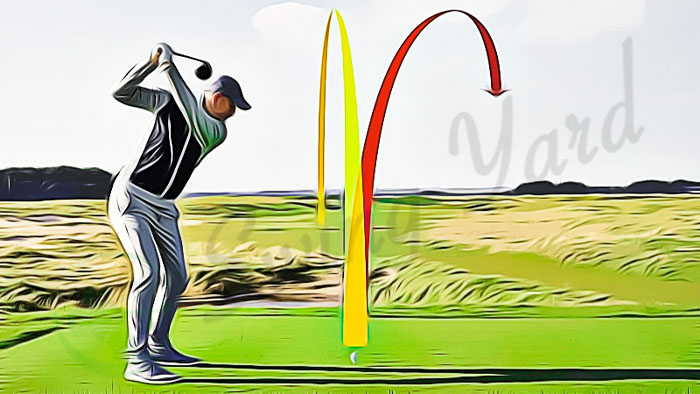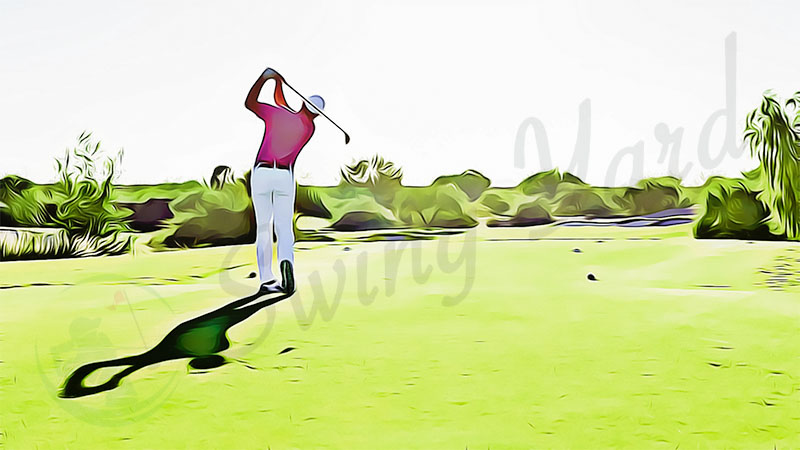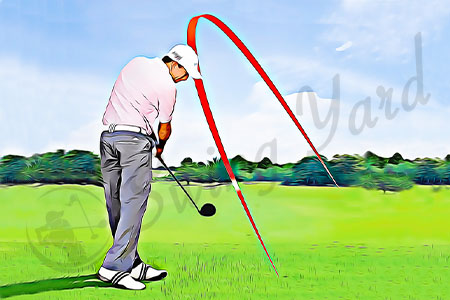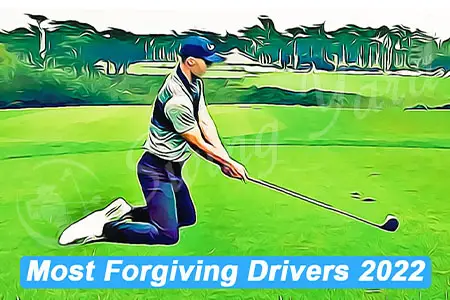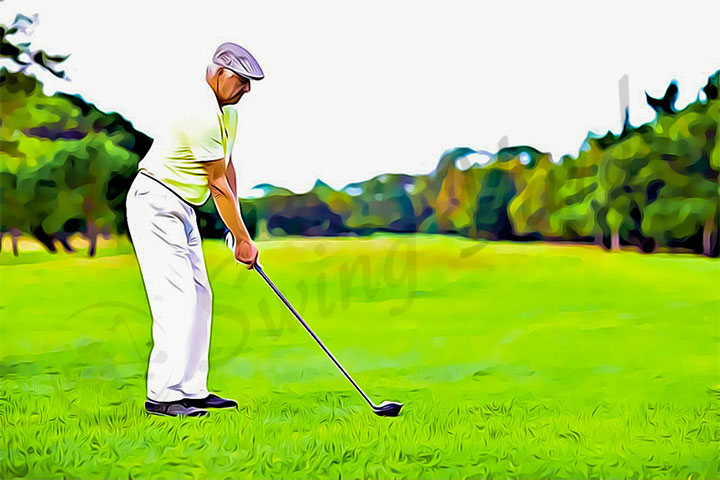Golf 101: The Ultimate Guide to Golfing for Beginners + Swing Tips
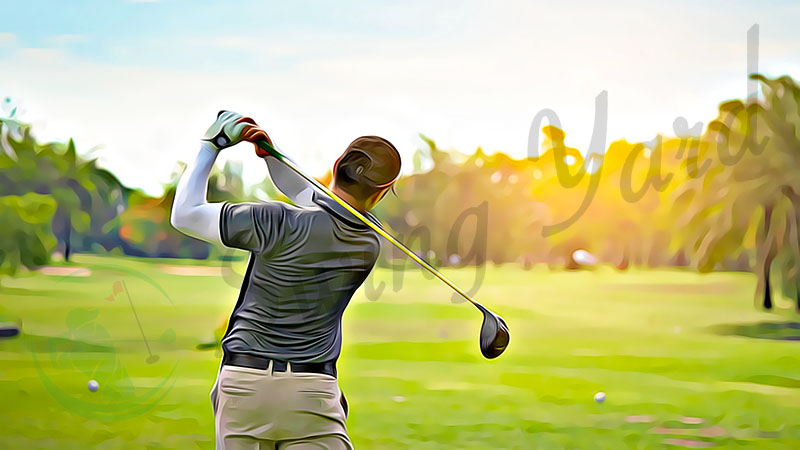
By Coach Erik Schjolberg – Jan 6, 2024
Contents
Key Takeaways
- An ”All In One” starter golf club set is your best bet for your first set of clubs
- Start out at the practice range getting used to hitting golf balls
- Don’t take yourself too seriously or even keep score at the start
- Play smart, and stay away from the foolish shot
- Use hybrids instead of long irons (easier to hit)
- “Par” is the assigned score for each hole (3, 4, or 5)
- “Birdie” is one stroke less than par
- “Bogie” is one stroke more than par
- Play your ball as it lies (outside of a hazard or marked on the green)
- “Handicap” is a measurement of performance for a golfer (low handicap = better player)
- Know your etiquette! Proper dress and manners
- Find what grip works for you
- Remember to have fun!
The modern game of golf has been around since the 15th Century. It was created at the Old Course in Saint Andrews, Scotland. However, over time, it lost popularity until somewhat recently (150 years ago).
Now is the perfect time to take up the game, and its popularity is actually rising even more.
Golf allows us the luxury of getting outside for much needed sunlight, exercise, camaraderie, and FUN! If you’re walking the golf course and using a push/pull cart, the average game is about 11,000 to 14,000 steps, or about 4 to 6 miles.
Most rounds of golf take about 3 to 5 hours, depending if you’re playing alone, with someone, or in a tournament. I can generally walk 18 holes of golf playing alone in about 2½ to 3 hours.
Note – this is a pretty MASSIVE GUIDE… so use the table of contents at the top to navigate around, or use the following:
- “Golf 101 – Beginners Guide to Golf” – for info on how to start playing, what equipment you’ll need, the rules and terminology, etiquette, first time out on the course, etc.
- “Beginner Golf Tips” – for learning more about the technical aspects for beginners like swing tips and fundamentals, grip basics, the distinctions for hitting different club types, the various shot types you’ll need to make (full swing, pitching, chipping, putting), etc.
- Swing Drills – to get your started practicing in the right direction
- Frequently Asked Questions
Golf 101 – Beginners Guide to Golf
Note – refer to the definitions section for any of the terms marked in ‘ ‘ throughout the article, as well as a list of other common golf terms you should know.
If you’re a female golfer, this article definitely still applies to you, but check out our post on women’s golf tips as well.
How to Start Playing Golf
So how do you start playing this great game? Well, the first thing you need is a set of clubs! A starter “all-in-one” set should suffice for now. Or for females, a ladies beginner golf club set.
If you have any friends who play, try to get them to teach you the basics. If not, that’s okay too.
Find a nearby driving range, buy a bucket of balls, and start whacking away! Use the tips in this post (and others) to help you along the way.


Once you feel like you can at least hit the ball a little bit, you’re already good enough to play what’s called a ‘round of golf’, or 18 holes, this is where you get to ride in the golf carts!!
It’s THAT simple to get started playing golf…. But that IS just the start!
Tips for First Time Golfers
The absolute best tip as a seasoned teaching pro I can give someone who is just starting out, just go out and have fun! Golf for beginners can be difficult, don’t take it too seriously.
Enjoy the camaraderie with your friends, the exercise, and just being out in the sun. And don’t even worry about your score yet.
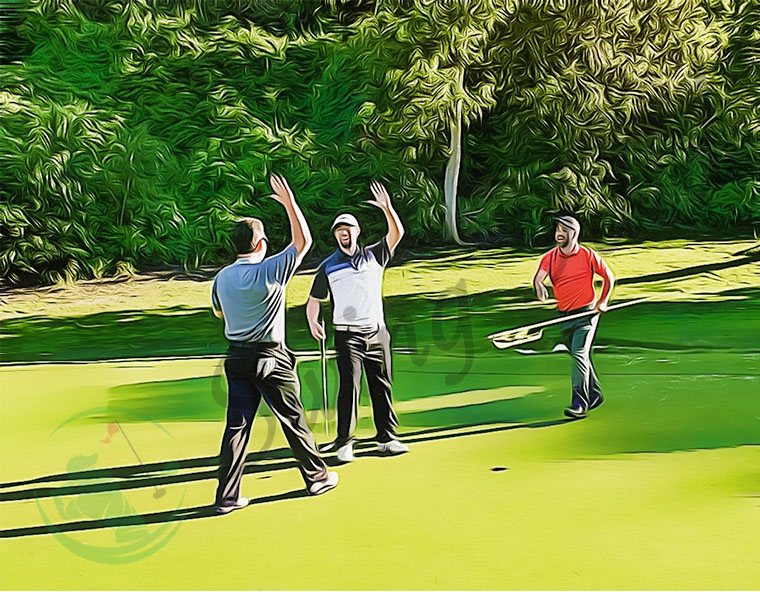

The second thing I’ll say is to play what is called “course management.” This means don’t try any foolish stuff and play each shot so it stays in the fairway as best you can.
These are the best two tips I can give a golfer just starting out.
One last thing on this, try to play a short par 3 course the first time out before tackling a full 18 hole golf course.
A par 3 course is usually only a few holes, 9 at the most, and all the holes are short par 3’s. It’s a good transition from the range before you play an actual golf course.
What are the Golf Clubs Needed for a Beginner?
14 clubs make up a legal golf bag. You can have less, but not more. Those are the rules. However, if you’re just starting out, you really don’t need that many yet.
Condensed Set (these are the clubs I recommend you carry if you’re just starting out):
- A Driver – to tee off with
- One fairway wood – 5 wood is best to start, it’s a little easier to hit than a 3 wood
- 21 or 22 degree hybrid – takes place of a 4 iron, which can be hard to hit for newbies
- One mid range iron – 6 or 7 iron – for long range approach shots
- One short range iron – 8 or 9 iron – good for short approach shots as well as some chipping situations
- One wedge – either a gap or sand wedge – used for really short approach shots, pitch shots, and chipping around the green or bunker
- One putter – for putting once you’re on the green
This setup gives you the most used and versatile 7 clubs out of the 14.
Full Set (all 14 clubs)
- Driver set at 10 degrees or higher
- Fairway wood at 14 degrees
- 3 hybrid, 4 hybrid, 5 hybrid
- 6iron – 9iron
- Pitching wedge, gap wedge, sand wedge, lob wedge
- Putter
Bonus Tip – Where does everything go in the bag?
It may seem obvious to some, but you’d be surprised how many non-beginner golfers still get this wrong! There is actually a right and wrong way to arrange the clubs in your bag.
With that said though, the absolute best way to arrange your bag is the way that works best for YOU and your tendencies.
Check this video out, take what you like, and discard the rest. I do about 90% of what he says, and then customize the rest to the exact way I like things.
Golf Rules for Beginners
For a new golfer, the rules can be a nightmare to muddle through. I’ve found that the best rule is to keep it simple at first, and absorb the rest as you progress.
- Everytime you swing and make contact with the ball, that’s a ‘stroke’
- The object is to finish each hole with a few strokes as possible
- Each hole will be assigned a score of 3, 4, or 5 ‘Par’
- You will get a ‘birdie’ for scoring 1 less than par, a ‘Par’ for matching par, a ‘bogey’ for 1 over par, a ‘double bogey’ for 2 over par… etc etc
- Typically, you’ll keep track of your total strokes, as well as your total score to par. So you’ve played through 9 holes, the par score is 36, and you shot 40 strokes, you are ‘4 over’ at that point in the round
In most cases, you play your ball from the exact spot that it lands. You don’t physically touch it, pick it up, etc. You hit it as it lies. There are a few exceptions though: - If you’re in a marked ‘hazard’ area, you can take a ‘drop’ for a one stroke penalty
- If you’re on the green, you can mark your ball, pick it up, clean it, etc, until it’s your turn to put. At that point you put it back where you marked it, pick up the marker, and proceed.
- Although not an official rule, if you’re in a rocky area, rooty area, etc and you feel that you may damage your clubs and/or your body/hands, then pick it up and drop it near by in a better lie.
- You can take as many practice swings as you want, as long as you don’t hit the ball, it doesn’t count towards your score.
- You can NOT make contact with the sand in the bunkers on your practice swings.
- If you hit the ball in the water (or any lateral water hazards) you must take a drop from the last spot it crossed prior to going into the hazard.
Learning the areas of the golf course and what is allowed in them can help newbies understand what to do. But for the first few months of play, I wouldn’t push too many rules since their minds are filled with trying to hit each shot and “not be too embarrassed” while playing.
So go easy on yourself while you’re learning!
What is a Golf Handicap for a Beginner?
The term ‘handicap’ simply serves to measure the performance of the player. The higher the handicap, the less skilled they are.
Most new players will fall underneath the category of a high handicapper. But not to worry, the more you practice and play, the better you’ll get, and the lower your handicap will become.
Handicaps allow you to play evenly and be on the same playing field with better players. Sometimes, you may have an advantage over the low handicappers simply because there will always be a time that you play one of your best rounds, and with your handicap, this could mean you actually have a better net score.
Just a bit of information, your gross score minus your handicap equals your net score.
A beginner golf handicap is going to be around 25 or 30 (meaning you typically shoot 25-30 strokes over par).
Another tip is to play with golf balls made for high handicappers.
Golf Terms for Beginners
- Approach shot – the shot you hit when you’re coming into and trying to land on the green
- Birdie – completing the hole in one less stroke than par
- Bogey – completing the hole in one more stroke than par
- Divot – a small shallow hole left in the ground after you take a swing
- Double Bogey – completing the hole in two more strokes than par (catch the trend?)
- Eagle – completing the hole in two fewer strokes than the par
- Fairway – the stretch of shorter grass that directs you to the hole (it’s where you want to be)
- Fore – what golfers yell (hopefully loudly) when they hit a bad shot to alert other golfers in the area to watch out. Generally translated as “duck and cover.”
- Green – the area of finely trimmed grass at the end of each hole (it’s where you want to end up). This is where you putt into the hole
- Hazards – usually water or really tall grass. Designated by red lines or stakes. If your shot goes here, you technically can play it if you choose, but usually you would take a drop.
- Hole-in-One – getting it in the hole on your first shot; a moment a golfer, nor their bar tab, will ever forget. Note: any player achieving this feat is expected to buy all patrons of the 19th-hole (the bar in the clubhouse) a drink upon finishing the round
- Hook – a golf shot that moves severely right to left for right-handed hitters and the opposite way for lefties, not to be confused with Peter Pan’s nemesis
- Lie – the way the ball has come to rest on the ground. It may be on a “good lie” in short grass on the fairway or a “bad lie” in deep grass in the rough. You may have a sidehill lie, where the ball is either above or below your feet
- Marshal – the man or woman who drives around in the cart monitoring the speed of play. You do not want to be visited by the marshal, that means you’re a slowpoke, which will not win you fans on the golf course
- Mulligan – an unofficial “redo” or “re-hit” that is undoubtedly a golfer’s best friend
- Out of Bounds – golf’s point of no return; white stakes designate an area is out of play for golfers. You typically have to re-hit your last shot with a two shot penalty.
- Par – the number of strokes the powers that be determined a player should take to complete the hole
- Pin or Flag – the object used on the greens to mark the hole
- Rough – the areas of longer grass that line the fairway (it’s where you don’t want to be)
- Sand Trap / Bunker – the sand-filled pits of despair that line fairways and guard the greens
- Slice – a shot that moves severely left to right for right-handed hitters and the opposite way for lefties, which also happens to be the most common shot shape in golf
- Starter – the man or woman stationed at the first tee who makes sure you tee off on time
- Stroke – what you have when you miss a short putt; just kidding, refers to the act of making a swing and contacting the ball
- Tee Box – the designated area that marks the beginning of each hole (It’s where you tee off from)
- The Beach – another name for the bunker/sand trap
- Three-Putt – when it takes you three putts to get your ball in the hole; also, the quickest way your putter earns a trip to the time-out closet, or in the lake
Golf Etiquette for Beginners
(you need to know these)
The most essential piece of golf etiquette I could offer a beginning golfer is to allow faster players to play through. Not doing so is frustrating to those behind the slow players, and frustrating to the rest of the players behind them, and so on.
A good rule of thumb is to allow all of those faster players to pass when you come to a par three, maybe the snack bar, or another resting place on the golf course.
Another form of etiquette that goes along with golf courses is proper attire. Nearly all clubs offer you the choice of dress pants/shorts, a polo shirt, and golf shoes. Cutoffs, tee shirts, jeans, and sandals are strictly forbidden.
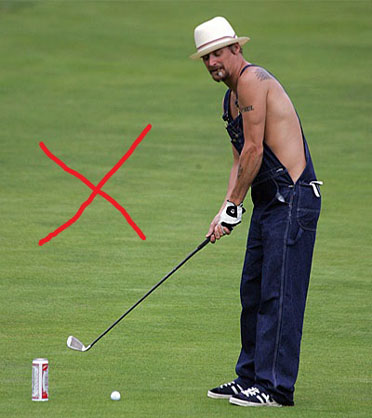

One more tip is to learn that the player farthest away from the pin always goes first, unless told by others in their group to play what is known as “ready golf.” Letting those who are farthest from the pin/flag is called having honors.
Honors is also a term for allowing the person with the lowest score on the previous hole to tee off first. Ready golf means just that… the first person in the group who is ready to play may go ahead and play.
If people are ahead on the green, but you can’t legitimately make it to the green on your next shot, go ahead and lay up (shoot a shorter shot). Don’t be this guy…
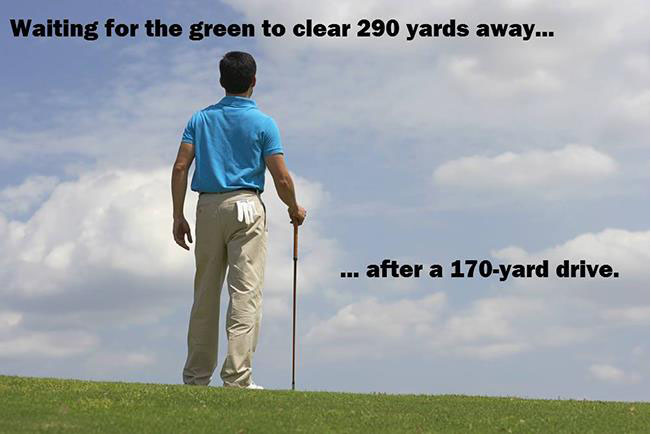

Some other big ones are to not to talk while others are taking their shots, don’t walk in front of someone getting ready to shoot, wait until the group in front is out of your way before you shoot, and try to enjoy the game, regardless of how you play that day.
And don’t walk in front of someone’s putting line!
Beginner Golf Tips
Golf Swing Tips for Beginners
The first time you pick up a club and try to swing, it may feel quite awkward. This is pretty normal. Golf is a little bit like swinging a baseball, combined with swinging a Cricket bat.
However, the fundamentals are a bit different. In the following paragraphs, I’ll give you some basic fundamentals involved in the swing.
Beginner Golf Grip Basics
Before taking your first attempt to swing, you’ve got to learn the proper grip. This same principle applies to learning to grip a baseball bat, tennis racket, or even a hockey stick.
Here are the basics for now.
In golf, there are three different grips. One is the exact same as gripping a baseball bat, another is the overlap grip where the bottom little finger overlaps the index finger of the top hand, and the final is where the little fingers on both hands interlock.
Typically, on the top hand, as you grip the club, you should see the knuckles of your index finger, middle finger, and some will teach the ring finger. The following illustration shows the different grips from strong to weak.
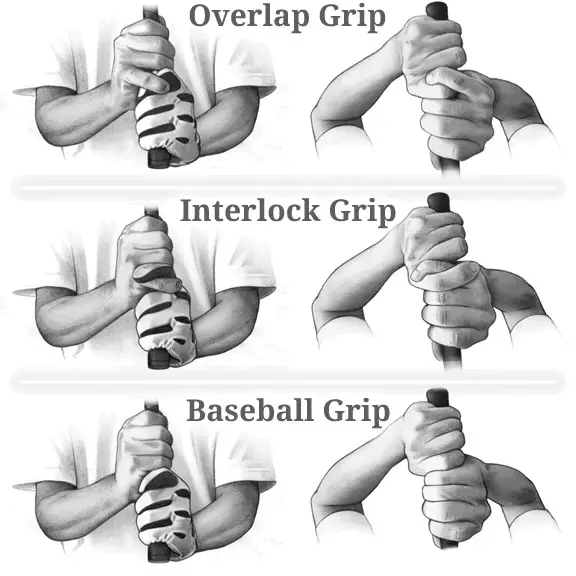

How to Swing a Golf Club for Beginners
Now it’s time to learn how to swing a golf club for beginners. There are four basic golf swing fundamentals for beginners you must master (eventually) to make the proper beginner golf swing.
Golf Swing Basics for Beginners
The first 2 basic moves happen in the backswing. In this part of the swing, you first begin to transfer your weight to your trail foot, and at the same time, or a split second after, you start the backswing with your arms, while rotating your hips and upper body pretty much all at the same time.
At the top of the backswing, you really do want a slight pause to allow yourself to complete what is known in golf as the ‘coil’, before you start to uncoil and move into the next phase.
Next, In the transition phase, your body should begin to uncoil before your arms and hands begin the downswing. This move causes the necessary “lag” needed to create the maximum amount of power.
Finally, as your arms and hands begin to come through the shot, your body should already begin to point down your target line.
Check out this sequence photo of Dustin Johnson below, you can really see the various parts and checkpoints of the swing in detail…
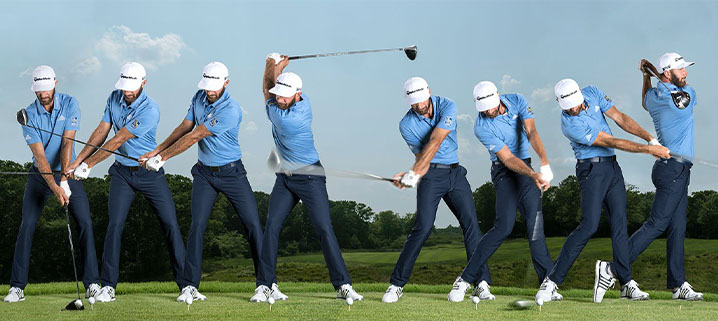

How to Hit a Golf Ball for Beginners
Now that you know how to “grip it and rip it” (shoutout to John Daly for that one), you’re ready to finally hit a ball!
Combining everything you’ve learned up to this point, simply place a ball on the ground in front of you (or on a tee if you want to make it a little easier starting out).
Keep your eye on the ball during the backswing, and up until the point where you make contact with the ball. It’s that simple! You’ll still need some refinement, but that’s what the entire rest of this article is for!
How to Hit Driver for Beginners
Just the basic concepts here, we do have a full in depth article JUST on the golf driver swing if you want to check that out.
So how do you hit the driver?
- The driver is by far the longest of the clubs in your bag, which makes it the hardest to hit. Choke down on your driver for control.
- The standard way to tee the ball is where the ball’s equator is half below the top of the driver and half above the driver
- Next, the ball position should be teed near your lead heel or even up to your lead toe.
- You’ll want to take a wider stance than you do with your irons.
- Tilt your upper body slightly back towards your trail side.
- Begin the swing by dragging your driver along the ground for about a foot or two before you begin to take it off the ground.
- Keep your body tilted slightly back throughout the entire swing so when you’re at the point of impact, you’re hitting UP on the golf ball.
- If you have alignment sticks, you can practice your ball position. One stick should be down your target line and the other 90° to your target line for lead foot placement and ball position.
And if you’re in the market for a new driver, check out our extensive review of the best golf drivers for beginners and high handicappers. Some real surprises in there!
How to Hit Irons for Beginners
Irons are a little bit different than the driver, and generally start developing once you learn how to break 90 or so.
First off, the ball position is not up on the lead foot, but rather back towards the center of the stance.
With long irons (your 3, 4, and 5 iron or hybrids) the ball should be placed slightly forward of center.
For mid irons (your 6, 7, and 8 irons) the ball should be placed right at the center of your stance.
And for short irons (your 9 iron and wedges) the ball should be placed slightly behind center.
Another difference is in your stance. It’s not as wide as the stance for your driver. The stance for your fairway wood and all of your irons is shoulder width, and sometimes a bit narrower. Your weight is more to your lead foot, maybe 55% to 60%. This helps you hit down and ball first before you contacting the ground.
The correct impact for irons is ball first, then the ground.
Remember, in both swings, for your driver and for your irons, your head should remain in relatively the same position as it was at your address. Moving your head or adding a sway to your body, with both driver or irons, will more than likely cause you to strike it thin (on top of the ball) or fat (behind the ball or ground first).
If you have alignment sticks, you can practice your ball position. One stick should be down your target line and the other 90° to your target line for ball placement.
Chipping and Pitching for Beginners
Chipping and pitching are pretty much in the same category (as a new golfer at least). The stroke and setup are pretty much the same. The main difference is the distance of the shot.
Let’s Look at the Longer of the Two… The Pitch Shot
Many professionals are using lofted wedges for this. However, depending on the lie and the shot, a lofted wedge could be better replaced by an 8 or 9 iron.
The setup and ball placement for a pitch shot are the same as for your short irons, which are in the center of your stance to slightly behind center.
The swing will depend on how far you need the ball to go in the air, but generally not much more than HALF of your normal full swing. This could mean half the backswing length, half the power, or a combination of both… it’s a personal preference and will take practice to develop the feel you like.
The finish of both the pitch and the chip should be facing your target.
And the Shorter of the Two… The Chip Shot
In chipping, unless you have an obstacle to go over like a bunker, OR the green is well above your lie, then you’ll want to get the ball rolling on the green sooner rather than later.
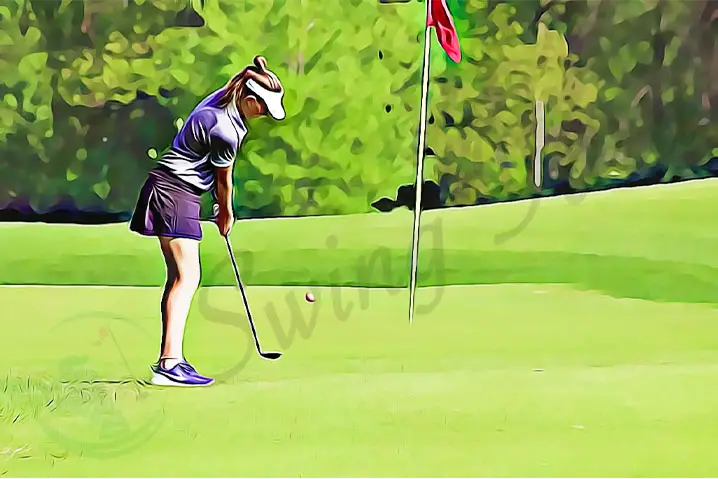

There are several schools of thought about this…
Old School Method
Most of those in the older generation prefer to use a non-lofted iron, such as 6, 7, 8, or 9 iron, or even possibly a hybrid or fairway wood to accomplish this. We prefer the ball flight to be relatively short and have the ball rolling most of the way to the cup/hole.
Also, many of us in the “old school” way of thinking will place the ball much closer to the trail foot, thus shortening the flight, and getting the ball rolling on the green faster.
The stroke for our chipping shots would be very similar to our putting stroke, rocking the shoulders and keeping our hands still. And finally, our stance is with both feet together and not apart.
New School Method
The new school way of thinking on chip shots is quite a bit different. Now, the teachings are in ball placement, which is much closer to center and not nearer to the trail foot.
The stance in the new way of thinking is slightly apart, maybe about 6 inches or so, and the even newer teachings prefer using more lofted clubs such as one of your wedges.
Not too many of the newer instructors teach the idea of using non-lofted clubs for chipping. When using more lofted clubs, you must fly the ball closer to the hole with much less rollout.
The stroke for this school of thought is pretty much the same as your putting stroke, which is just rocking the shoulders, using what is called “the big muscles,” and keeping the hands still. However, a few teach cocking the wrists and using your body and shoulders to pull the club through.
Cross Handed Method
There is one more way to pitch or chip though. This may seem weird for some, but because I tend to be a little wristy, I’ve adopted the same method that VJ Singh chips.
This method is called “cross handed” pitching and chipping, meaning, to a right-handed golfer, left hand low; and to a left-handed golfer, right hand low.
Regardless of if you’re right-handed or left-handed, the grip position of your hands is the exact opposite. It will feel weird at first, but if you find you’re a little wristy and constantly having the yips, this method will pretty much eliminate those yips and allow your short game around the green to improve.
Golf Putting Tips for Beginners
Two steps to being a great putter are your alignment and setup.
Typically, in alignment, your feet should be 90° to your target line. If you were to put an alignment stick just in front of your toes, it should be pointing directly at your target line (not necessarily the hole, since not all putts are straight in).
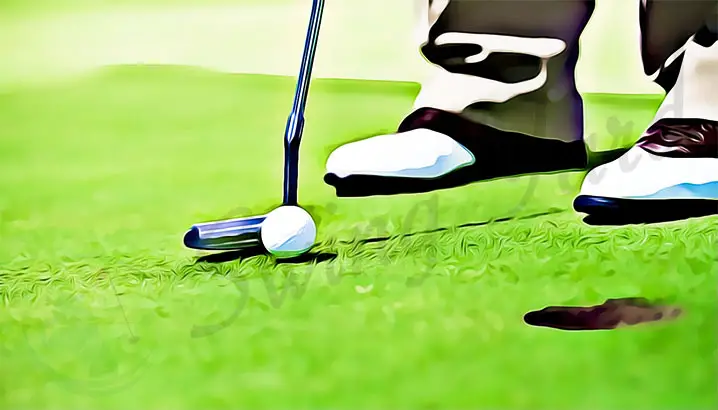

Next is your ball placement. This should be just in front of the center of your sternum. This way, at impact, you’ll be hitting up slightly on the ball, thus keeping it on the ground vs skipping it through the air. That tends to happen when your ball placement is behind center and you hit down or with a descending blow.
Your eyes should be directly over the ball at address, so you can look straight down your target line. If you want to test this, hold a ball directly between your eyes and drop it. If you’re set up correctly, the dropped ball should land either slightly behind the ball you’ve placed on the ground or on the back of that same ball.
There are quite a few ways to grip the putter. It’s really up to feel and personal preference.
You could grip the putter the same as you grip your irons… you could grip it with palms together and your fingers pointing down the shaft… or grip it normally with one hand while the other forms a claw type grip.
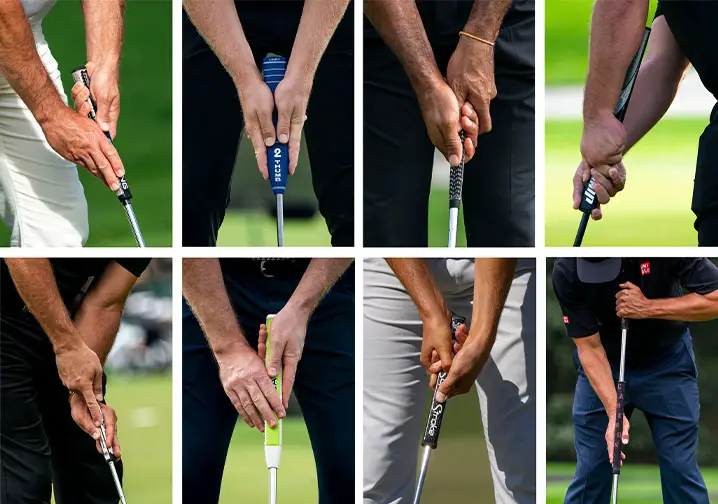

However you decide to grip your putter though, it should be with a very light, non-pressured type of grip.
The length of the putter stroke will depend on the length of putt you have. The path of the stroke should be straight back and forth, or just slightly arched off the center line. The more you deviate from the straight back, straight through putting stroke, the more chances you have to either push or pull your putt.
Just a note, for those of us, like me, who prefer to use the long putter, now known or commonly referred to as a “broomstick” putter, the ball position, address, and putter stroke are still the same.
Golf Essentials for Beginners
What do you need to start playing golf? Of course, you’ll need clubs, a bag, golf balls, and possibly a glove. Gloves come in packages of one, two, or even three, but they are all for the same hand, the lead hand for right handed golfers.
You’ll want a visor, cap, or some type of hat as you’ll be exposed to the sun for 3 hours or more. A good sunblock for those who have sensitive skin.
Since tee shirts and cut off styles of shorts are generally not allowed, you’ll want to have polo style shirts designed to wick away perspiration from your body. And some type of casual shorts or slacks for men and skorts for women.
Some clubs are allowing women to wear jogging style pants, but basically, what most clubs are looking for is known as “business casual” type attire.
Even though some type of golf shoe is recommended, a jogging or walking style of tennis shoe will work as well. Now, there are many clubs allowing sandals, since a few manufacturers are making golf sandals, but you must wear socks with the sandals.
After all of the essential items, a good place to start is at your local range with an instructor, or at a golf course where you can receive lessons. I’ve seen players trying to learn the game on golf courses by themselves with no instructor to help, and it’s generally been a disaster, to say the least.
It’s always better to bite the bullet and get a few lessons before attempting to play some courses.
Golf Books for Beginners
There are a lot of good books on the market for beginning golf.
- The Golf Handbook
- Golf for Dummies
- Good Golf Made Easy
- Golf Fore Beginners
- A Beginner’s Guide to Golf
- Feeling Naked on the First Tee for women
- A Girls On Course Survival Guide to Golf
- Ben Hogan’s Five Lessons – one of my absolute favorites
Bonus – it’s always a good idea to join the USGA so you can receive a copy of their On Course Handbook of Golf Rules.
Golf Swing Drills for Beginners
Weighted Swing Aid Drill
One of the best ways to practice your swing is by using either a weighted ring you slide down your shaft, or what is known as a “whip.”
Both of these items teach you to transfer weight from one foot to the other correctly, and condition you to properly use your hips (which is where you get all your power and distance from).
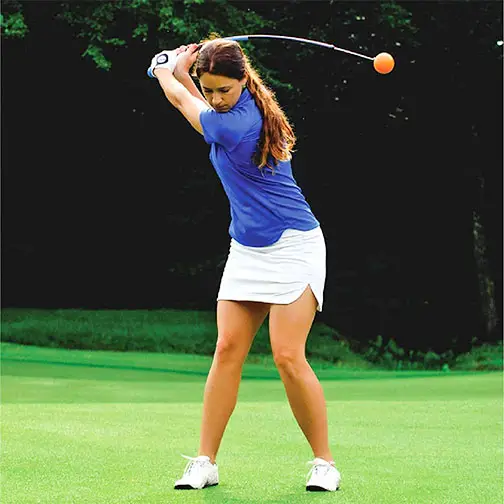

Both of these items will help teach your body the proper swing, as well as condition your upper and lower torso for more power and distance. There are many more types of swing-aids on the market, but I found either one of these to be the best for new golfers just starting out and learning.
Backswing Rotation Drill Using an Alignment Rod
Address the ball like you normally would, but instead of gripping the club in your hands, using either a club or an alignment rod, cross your hands and hold the rod across your chest and shoulders so that it’s parallel to your shoulder line.
Now, rotate your hips, waist, and shoulders to simulate your backswing. Stop rotating when the alignment rod and your LEFT shoulder is pointing straight down at the ground. This should be a perfect 90° rotation… and is the position you should stop in at the top of your backswing.
Practice this rotation about 10 times, and do this drill each time you get to the range BEFORE you start hitting.
Here’s an example of the drill using an alignment rod…
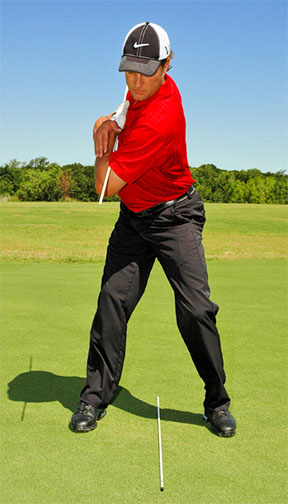

Downswing Rotation Drill Using an Alignment Rod
Similar to the previous drill, use an alignment rod or club held up against your chest and shoulders.
This time, you’ll be rotating from the top of the backswing position down into your impact position. This one is a little bit harder to get right, but try to understand the following:
Your hips should lead the rotation (uncoiling), followed by your torso and chest, then your shoulders last.
Rotate until the alignment rod and RIGHT shoulder is pointing down at the ground. Your hips should be OPEN and pointing towards your target. Your chest should be open as well, and about halfway between your hips and shoulders (towards the target, but not directly at it yet).
These are the basics of the impact position (the point where you contact the ball).
Practice this rotation about 10 times individually, and then combine it in with the backswing rotation drill.
Once you can do the full backswing and downswing with an alignment rod on your chest (and you’re getting in the right check points I talked about with the alignment rod and where it points), try doing slow swings with the club in your hands, while still checking off those same check points with your shoulders.
Check out this sequence shot by Tiger Woods… this is a good visual for the shoulder reference points for both of these drills…
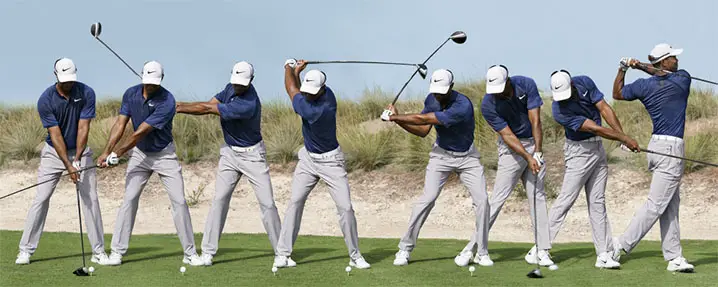

Rotation Drill to Keep Hips from Swaying Away or Towards the Target
This one is a HUGE mistake I see a lot of new golfers making… swaying either away from or towards the target.
This guy explains it really well and has a great drill to fix this issue:
Ball Striking Drill With 3 Balls
It’s super important to learn to make contact with the golf ball first and on the way down in your downswing. This drill trains exactly that.
Put 3 balls out in front of you in a line going away from you, maybe 3 or 4 inches between them… enough so that you don’t contact the other two balls accidentally.
Aim to hit the ball that’s in the middle. The object here is to strike the ball first, concentrating on contacting the ground AFTER you make contact with the ball.
The other two balls are really just there for reference points after you have taken your swing. Check to see where the divot is in the grass (this can only be done on a range that has grass).
The divot should be slightly IN FRONT of the other two balls. If it’s not, try to make the adjustments in your head, and try again.
Work on this until you can get the divot in front of the balls at least more than 50% of the time.
Note – you can use tees instead of balls if you feel that you’re not good enough yet to avoid striking the other two reference balls.
Clubface Awareness Drill
Perhaps one of the most important things to be aware of when hitting balls is where the clubface is pointed at impact. This may be slightly more advanced, but it’s good to start gaining this awareness as soon as you can, especially if you need to stop slicing your driver.
The actual drill is quite simple… you’re just going to be hitting slow and easy shots while you’re at the range.
BUT, it’s what you’re focused on that makes this a “drill”.
Set out 15-20 balls. For those balls, you’re not worried about any of the other stuff we’ve talked about with the shoulder turn, making contact with the ball first, etc. You’re ONLY focus should be on task at hand.
And that task is to SQUARE the clubface at impact. That means that your clubface will be exactly perpendicular to your target line when it makes contact with the ball.
An open face means that it’s slightly pointed out to the right, or away from you. A closed face means that it’s slightly pointed out to the left of the target line.
Really concentrate on learning how to square the ace at impact for these 15-20 balls. You’ll know you’re doing it right when you start to get really solid contact with the ball, AND your shots are going relatively straight.
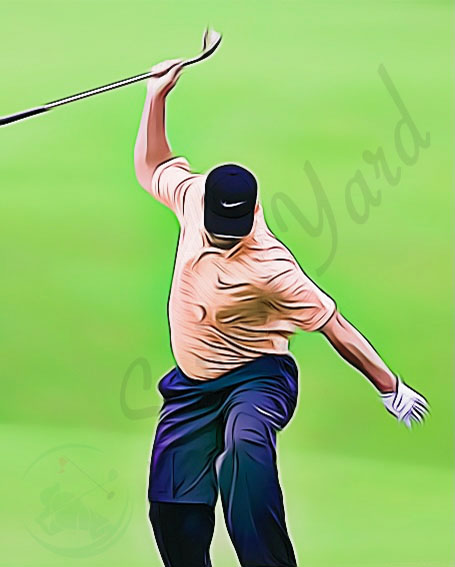

FAQ – Golfing for Beginners
Note – Some of these FAQs were covered throughout the article, but I still get these questions a lot… so here are the “short and sweet” answers to the most common questions:
What Is Needed to Start Golfing?
- Clubs
- Balls
- Tees
- Bag
- Glove
- Proper attire
Where Do I Start With Golf?
The best place to start with golf is on the driving range with an instructor, or at one of your local golf courses with a teaching pro. I don’t recommend, if you’re just starting out, to go and play any course until you’ve learned some of the basics and hit several buckets of golf balls on the range.
Is It Worth Getting Golf Lessons?
Are golf lessons worth it? Yes, very much so in my opinion. You don’t need to take a lesson every week, but a few lessons will give you the golf swing fundamentals for beginners, and the right mechanics for you to go work on at the range yourself… before you actually play a round on the course.
Do I Really Need Golf Shoes?
No, you don’t need golf shoes as long as the weather or course you’re playing is dry. They’re recommended for the reason of slippage if wet conditions exist, but not required or needed. Tennis shoes would suffice if the course is dry.
What are the Golf Scoring Terms?
- Albatross (3 under par)
- Eagle (2 under par)
- Birdie (1 Under par)
- Par
- Bogey (1 over par)
- Double Bogey (2 over par)
- Triple Bogey (3 over par, sometimes referred to double par on Par 3’s)
- Double Par (Sometimes called a Snowman)
What’s the Average Golf Score for Beginner?
The average score for a brand new beginner is probably going to be well up over 100. And the score might not be all that accurate either since, as a newbie, you’ll probably be re-hitting some shots, improving your lie, etc (which would not normally be allowed in play).
Honestly, if you can just get through the round and just hit some decent shots here and there, you’re on the right track.
As you get a little bit better, a good score to shoot for is right around 115. Once you can do that, see if you can break 110, then 105, and so on.
A few “mile markers” for scores to aim for (or less) are 100, 90, and eventually 80. If you’re able to break 80, you’re doing great! This will probably take several years and dedication though.
Is It Ok to Play Golf By Yourself?
It’s perfectly ok to play golf by yourself. I do it quite often, but it’s always better to have a companion on the course with you for camaraderie, and if he’s better than you, for advice!
What are the 14 Clubs in a Golf Bag?
- Driver
- 3 Wood
- 5 Wood or 3 Hybrid (a hybrid’s number corresponds to the “equivalent” iron, not the wood)
- 4 Iron or 4 Hybrid through 9 Iron
- Pitching Wedge, Gap Wedge, Sand Wedge (not just for sand), and Lob Wedge
- Putter
What’s the Easiest Golf Club to Hit?
The easiest golf club to hit depends on each individual. I prefer the 7 iron. Each one of us has our preference that we think is the easiest, it’s usually going to be a mid or short iron though.
What Is the Best Age to Learn Golf?
I think the best age to begin to learn golf would depend on the attention span and drive of that individual. I started playing at the age of 7.
However, I think I put too much pressure on myself and was a little too hot headed on the course. In most cases, a child the age of 7 or 8, if they want, is in the proper age bracket to begin playing their golfing career.
How Do You Become a Good Beginner Golfer?
To become a good beginner golfer, you must be willing to PRACTICE at the range. You can basically just whack tons of balls with no pressure, and nothing really matters.
Until you can make contact with the ball and get it up in the air on at least 50% of your shots, you’re probably not ready to play an actual course.
Also, practice all 3 phases of the game… the full swings, the pitching/chipping, and putting
How Should a Beginner Swing a Golf Swing?
A beginner should swing a golf swing only as fast as you can control it, while still making contact with the ball most of the time. If you’re missing balls completely, or even just hitting them fat (behind the ball) or thin (hitting the top of the ball), then you’re probably swinging too hard for your own good.
A swing that contacts the ball in the sweet spot (basically, the center of the face) will be a phenomenally better shot than one that doesn’t… regardless of how hard you’re swinging. This game is all about making good controlled contact with the ball!
How Can I Get Better at Golf Fast?
To get better at golf fast, take lessons! There are so many bad habits you’ll learn and program into your swing if you’re trying to do this alone. And it’s much harder to unlearn those bad habits later on.
While lessons aren’t necessary to learn, they ARE necessary if you want to learn quickly (and the right way of course).
Final Thoughts – Golf Tips for Beginners
The best time to start something new is 10 years ago… the next best time is NOW!
Now is the time to take up this fun game of golf. It’s not only a good source of exercise (especially if you walk the course) and natural Vitamin D (from the sun), but it’s probably one of the best ways to spend quality time with friends and family outside in a friendly competitive setting.
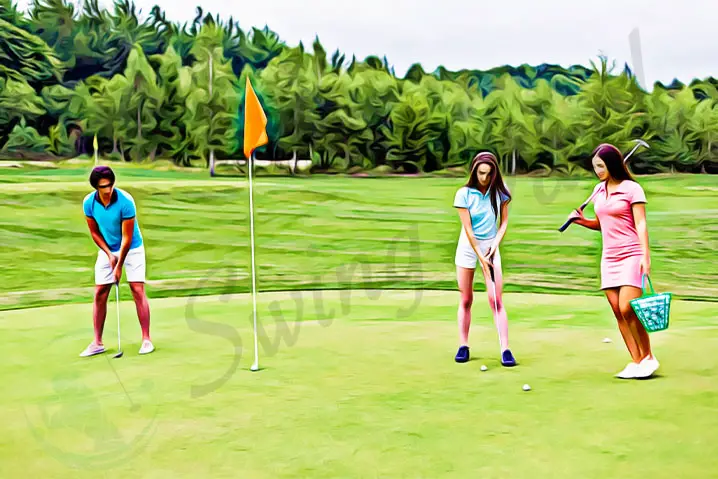

Learning the game is just a matter of going out and choosing to have fun while you do it.
Much of your equipment can be purchased second hand, so you don’t have to “break the bank” while buying it. There are many excellent free online instruction articles (like this one), and videos available on YouTube if you’re on a tight budget and can’t really afford lessons. There are tons of books available as well.
Most of the clothing required for the game you have in your own closets already, so it’s not necessary to go out and purchase a lot of expensive attire to get started. Far as where to store golf clubs, you can tuck them away in the closet or garage.
Finally, golf is great for our mental health as well, provided you don’t put a lot of pressure on yourself when you play. Take the game as a form of fun, enjoyment, friendship, and exercise, and you might be surprised at how good you feel after a round… then you can take the next step: learning how to break 100!


